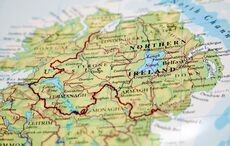The political system here is still reeling after the local and European elections two weeks ago which saw the collapse of the Labour Party, a drubbing for Fine Gael, a significant recovery for Fianna Fail, a much-hyped "breakthrough" for Sinn Fein and the election of a very big and very mixed bag of independents.
Since then the Labour leader Eamon Gilmore has resigned. And the parties are still trying to work out what it all might mean in two years time when we have the vote that really matters, the next general election for the Dail (Parliament).
The strong performance by Sinn Fein, particularly in the European elections, has led to a wildly optimistic reaction from some commentators in the U.S. One headline talked about Sinn Fein's big leap forward. Another suggested that we should not rule out Gerry Adams as the next taoiseach (prime minister)!
This is nonsense, of course. Yes, Sinn Fein got a few Euro seats thanks to some attractive candidates and the country-wide protest vote against austerity.
But as we pointed out here last week, the best indicator for what will happen in the next Dail election in 2016 is the local election vote. Sinn Fein got 15 percent of that, which was up from the 11 percent they got in the general election in 2011.
It was a good performance, but it has to be viewed in proportion (independents got 28 percent, Fianna Fail got 25 percent, Fine Gael got 24 percent and Labour got seven percent).
So although Sinn Fein did well, it's a long way from breaking the mold of Irish politics. That did not stop various unlikely scenarios being put forward by Sinn Fein admirers.
One was that in the next Dail election the combined opposition vote might exceed that of the two main parties, Fianna Fail and Fine Gael, and on that basis Adams might be the next taoiseach.
The problem with that analysis is that many of the independents/others (who got 28 percent of the vote) are center or right of center and could never support either Adams or the leftist economic policies of Sinn Fein. Indeed many of them are refugees from the main parties.
There is also the fact that many of the protest votes across the nation are likely to return to the main parties in the Dail election. We know from previous elections that many people who vote in protest against the government of the day in the local and European elections (at the midway point of the Dail term) are much more careful about how they vote in general elections. So the main parties are likely to get a good deal of their "lost" votes back, particularly if the economy continues its slow recovery.
Even so, a lecturer in politics in one of the universities here has done an analysis of the voting results, and based on the figures says that Sinn Fein could win up to 30 seats in the next Dail election.
Of course, "up to" can mean anything. The fact is, however, that even with 20 or 30 seats in the Dail Adams' dream of being in government north and south of the Border in 2016, the centenary of the 1916 Rising, is likely to remain just that – a dream.
Both Fianna Fail and Fine Gael are dead set against linking up with Sinn Fein for the recent historical reasons we all know about, but also because of the socialist style policies favored by the Shinners.
Sinn Fein's cannibalization of the SDLP vote in the north is never going to be repeated in the south with a takeover of the Fianna Fail vote. The historical momentum just is not there.
In fact, some dreamers in Fianna Fail say that the reverse is more likely and that this scenario would eventually lead to the return of Sinn Fein stars like Mary Lou McDonald to the party she left – Fianna Fail.
The vision of a Fianna Fail-Sinn Fein coalition is a neat idea, unifying the Republican tradition in the south. But if the remarkable recovery in the Fianna Fail vote continues, they will be slow to roll out a coalition welcome mat for the Shinners.
Fine Gael, of course, are even more vehemently opposed to any arrangement with the Shinners. If the Fine Gael vote fails to recover in the next year or two, then the logical combination – and one many people here would love to see happen – would be a coalition government between Fine Gael and Fianna Fail.
That would put an end to the Civil War division, the only thing that divides the two main parties these days since they agree roughly on most economic and social policies. Finally ending the historical anachronism would be a great way to mark the 1916 Centenary and would be celebrated by the nation as a sign of a genuine new beginning.
Such a scenario would leave Sinn Fein as the biggest fringe player, along with the remains of the Labour Party and other small parties and independents further to the left. For them, it could be the start of a genuine left wing alternative opposition in the Dail.
That is the longer term scenario. The immediate problem that Sinn Fein is going to face in the next year or two in the run-up to the Dail election will be much closer scrutiny of its economic policies.
The Shinners had the luxury in this election of being able to oppose virtually all the austerity measures without really explaining how they would close the gap in the nation's finances. They can't play that game forever.
An example would be their opposition to the property tax. Even though it is progressive, so that people in bigger houses pay far more, the Shinners want it abolished and replaced by a one percent wealth tax on assets valued at over €1 million.
This would mean that someone living in a €1 million house (not that uncommon in the leafy Dublin suburbs) would have an annual wealth tax bill of €10,000 on their house alone, while most people would pay nothing.
The Shinners also want a new third rate of income tax of 48 percent on income over €100,000 (the current top rate is 41 percent). However, we also have income levies/charges so that the current effective top income tax rate is 52 percent, and if the Shinners get their way it will be 59 percent on earnings over €100,000.
Add that to the wealth tax and throw in increases of 10 percent in both capital gains and capital acquisitions taxes, and you have the perfect recipe for a flight of capital and high earners from the country.
And of course the Shinners are also against any water charges, even though the water grid is in desperate need of repairs costing billions and water is routinely wasted by consumers.
What Sinn Fein is not in favor of is any change to the generous and hugely expensive welfare system we have created here which has produced an entitlement culture that removes the incentive to work from significant numbers of people and is creating serious social problems of disengagement.
During the boom, this did not seem to matter all that much. Now that the money is gone we can't afford this anymore, and correcting it or even limiting it is very difficult. But instead of tackling the problem, Sinn Fein exploits it.
One of the interesting things in recent months has been to watch Sinn Fein trying to have it both ways – to move to the center to appeal to the middle class and still oppose any austerity measures or cuts that might affect the largely working class vote they get. Their changing stance on Europe is also interesting.
They used to be strongly critical of the EU, something that was popular since many people believe (with good reason) that Ireland was stitched up by the EU and the IMF when we were forced into socializing the bank debt and taking the €65 billion bailout.
Unstitching all that at this stage, however, is fraught with difficulty. Reneging on our debt repayments would badly damage our credit rating and make our budgets even more difficult than they already are.
So as the possibility of power has come closer, Sinn Fein is moderating its position. They are no longer anti-EU.
In fact, they now say they were never anti-EU (a bit like Gerry was never in the IRA!). And instead of renouncing our debt they now want to renegotiate it, which is exactly where the other parties are at.
The first step, however, has to be to get rid of our budget deficits and get our state spending more or less back in line with our tax revenue. As we all know, that requires taking a further €2 billion out of the deficit in the budget in a few months to meets next year's three percent deficit target.
And with the way health spending is going out of control (and that is not our only problem) that will be extremely difficult. It will also mean holding spending down at this new low level for years to come until tax revenue picks up again, which is why people like former Taoiseach John Bruton are saying we have at least 10 years of austerity ahead of us.
So far there is no sign that Sinn Fein is going to be responsible about the situation we face, preferring to take the easy and popular route, promise more spending and avoid any hard decisions about cuts. Good-looking, articulate, university-educated, "lily-white" candidates (unsullied by any heavy stuff in the North) – McDonald, for example, went to the expensive Notre Dame des Missions private school and then to Trinity College, and Dublin euro poster star Lynn Boylan went to UCD – may have attracted a surprising number of middle class protest voters in these elections. But these same voters will want real answers before they support Sinn Fein in a general election.
Gerry – or even Mary Lou – have a long wait before either of them will be taoiseach, if ever.




Comments